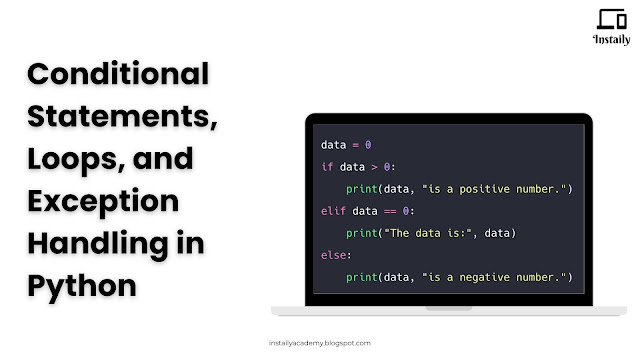A Tutorial on the Conditional Statements, Loops, and Exception Handling in Python
Unveiling Conditional Statements
Conditional statements are the backbone of Python programming, enabling your code to make decisions based on specific conditions. These statements evaluate whether a given condition is true or false and execute the corresponding code blocks.
The `if` Statement
The simplest among its counterparts, the `if` statement, checks a condition and executes a block of code if the condition holds true.
if condition:
# Execute this block if the condition is true
Let's illustrate this with an example:
# Checking if a number is positive
number = 10
if number > 0:
print("The number is positive")
Output:
The number is positive
The `if-else` Statement
The `if-else` statement extends the `if` statement by allowing you to execute an alternative block of code if the condition is false.
if condition:
# Execute this block if the condition is true
else:
# Execute this block if the condition is false
Consider this example:
# Determining if a number is even or odd
number = 11
if number % 2 == 0:
print("The number is even")
else:
print("The number is odd")
Output:
The number is odd
The `if-elif-else` Statement
For more complex scenarios involving multiple conditions, the `if-elif-else` statement proves invaluable. It checks conditions sequentially and executes different code blocks based on the first true condition.
if condition1:
# Execute this block if condition1 is true
elif condition2:
# Execute this block if condition2 is true
elif condition3:
# Execute this block if condition3 is true
...
else:
# Execute this block if no conditions are true
Here's an example:
# Determining a student's grade based on their score
score = 85
if score >= 90:
grade = "A"
elif score >= 80:
grade = "B"
elif score >= 70:
grade = "C"
elif score >= 60:
grade = "D"
else:
grade = "F"
print("Your grade is", grade)
Output:
Your grade is B
These conditional statements empower your code to make intelligent decisions and execute specific actions based on various conditions.
Unraveling Loops
Loops provide a means to execute a block of code repeatedly. Python offers two primary types of loops: `for` loops and `while` loops.
The `for` Loop
The `for` loop iterates over a sequence or an iterable object (e.g., a list, tuple, string, or range) and executes a block of code for each element in the sequence.
for variable in sequence:
# Execute this block for each element in the sequence
Consider this example:
# Printing each element of a list
fruits = ["apple", "banana", "orange", "grape"]
for fruit in fruits:
print(fruit)
Output:
apple
banana
orange
grape
The `while` Loop
The `while` loop executes a block of code as long as a specified condition remains true.
while condition:
# Execute this block as long as the condition is true
Here's an example:
# Printing numbers from 1 to 10
number = 1
while number <= 10:
print(number)
number += 1
Output:
1
2
3
4
5
6
7
8
9
10
Mastering Exception Handling
Exception handling is a vital technique that allows you to manage errors and exceptions that may arise during code execution. Python boasts a plethora of built-in exceptions, each serving a unique purpose, such as syntax errors, type errors, and more.
The `try-except` Statement
The `try-except` statement is the cornerstone of exception handling. It attempts to execute a block of code and catches any exceptions that may occur.
try:
# Attempt to execute this block of code
except ExceptionType as e:
# Handle the exception here
Let's explore this through an example:
# Attempting to divide two numbers and handling the zero division error
numerator = 10
denominator = 0
try:
result = numerator / denominator
except ZeroDivisionError as e:
print("Cannot divide by zero")
print("Exception:", e)
Output:
Cannot divide by zero
Exception: division by zero
The `try-except-else` Statement
Extending the `try-except` statement, the `try-except-else` statement allows you to execute a block of code if no exceptions are raised.
try:
# Attempt to execute this block of code
except ExceptionType as e:
# Handle the exception here
else:
# Execute this block if no exception is raised
Consider this example:
# Attempting to divide two numbers and handling the zero division error or printing the result otherwise
numerator = 10
denominator = 2
try:
result = numerator / denominator
except ZeroDivisionError as e:
print("Cannot divide by zero")
print("Exception:", e)
else:
print("The result is", result)
Output:
The result is 5.0
The `try-except-finally` Statement
The `try-except-finally` statement allows you to execute a block of code regardless of whether an exception is raised or not.
try:
# Attempt to execute this block of code
except ExceptionType as e:
# Handle the exception here
finally:
# Execute this block always at the end
Here's an example:
# Attempting to open and read a file, handling the IO error, and closing the file
filename = "test.txt"
try:
file = open(filename, "r")
content = file.read()
except IOError as e:
print("Cannot open or read the file")
print("Exception:", e)
finally:
file.close()
print("File closed")
Output:
Cannot open or read the file
Exception: [Errnor 2] No such file or directory: 'test.txt'
File closed
In Conclusion
In this comprehensive guide, we've embarked on a journey through Python's conditional statements, loops, and exception handling. These fundamental pillars empower you to control and manage the logic and flow of your code effectively. You've learned to make decisions using `if`, `elif`, and `else` statements, and how to iterate efficiently with `for` and `while` loops. Additionally, you've gained insights into handling errors gracefully using `try`, `except`, `else`, and `finally` statements.
We trust this guide has been instrumental in enhancing your Python programming skills. If you have any queries or feedback, please don't hesitate to leave a comment. Thank you for accompanying us on this educational journey!



Comments
Post a Comment